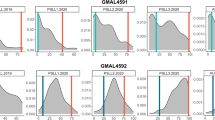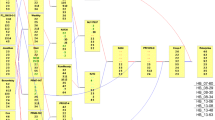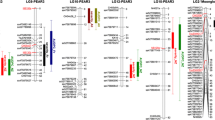Abstract
Since its first report almost 200 years ago, fire blight, caused by the gram-negative bacterium Erwinia amylovora, has threatened apple and pear production globally. Identifying novel genes and their functional alleles is a prerequisite to developing apple cultivars with enhanced fire blight resistance. Here, we report 13 strain-specific and environment-dependent minor QTLs linked to fire blight resistance from a segregating Malus sieversii × Malus × domestica mapping population. Interval mapping at 95% confidence and Kruskal–Wallis analysis at P value = 0.005 were used to identify QTLs for three strains of E. amylovora differing in virulence and pathogenicity. The QTLs identified explain a small to moderate part of resistance variability, and a majority was not common between years or E. amylovora strains. These QTLs are distributed in eight linkage groups of apples and comparison of their map position to previously identified fire blight resistance QTLs indicates that most are novel loci. Interaction between experimental conditions in the greenhouse and field, and between years, and differences in virulence levels of strains might be responsible for strain- and year-specific QTLs. The QTLs identified on LG10 for strain Ea273 in 2011 and strain LP101 in 2011, and on LG15 for strain LP101 could be the same QTLs identified previously with strain CFBP1430 in cultivar “Florina” and “Co-op16 × Co-op17” mapping population, respectively. We discuss the potential impact of newly identified minor fire blight QTLs and major gene-based resistance on the rate of mutation in pathogen populations to overcome resistance and durability of resistance.




Similar content being viewed by others
References
Aldwinckle HS, Preczewski JL (1976) Reaction of terminal shoots of apple cultivars to invasion by Erwinia amylovora. Phytopathology 66:1439–1444. https://doi.org/10.1094/Phyto-66-1439
Aldwinckle HS, Gustafson HL, Forsline PL (1999) Evaluation of the core subset of the USDA apple germplasm collection for resistance to fire blight. Acta Hortic (489):269–272. https://doi.org/10.17660/ActaHortic.1999.489.46
Baumgartner IO, Patocchi A, Frey JE, Peil A, Kellerhals M (2015) Breeding elite lines of apple carrying pyramided homozygous resistance genes against apple scab and resistance against powdery mildew and fire blight. Plant Mol Biol Report 33(5):1573–1583
Beavis WD (1998) QTL analyses: power, precision, and accuracy. Molecular dissection of complex traits 1998:145–162
Bortesi L, Fischer R (2015) The CRISPR/Cas9 system for plant genome editing and beyond. Biotechnol Adv 33(1):41–52. https://doi.org/10.1016/j.biotechadv.2014.12.006
Broggini GA, Wöhner T, Fahrentrapp J, Kost TD, Flachowsky H, Peil A, Hanke MV, Richter K, Patocchi A, Gessier C (2014) Engineering fire blight resistance into the apple cultivar “Gala” using the FB_MR5 CC-NBS-LRR resistance gene of Malus × robusta 5. Plant Biotechnol J 12(6):728–733. https://doi.org/10.1111/pbi.12177
Calenge F, Drouet D, Denancé C, Van de Weg WE, Brisset M-N, Paulin J-P, Durel C-E (2005) Identification of a major QTL together with several minor additive or epistatic QTLs for resistance to fire blight in apple in two related progenies. Theor Appl Genet 111(1):128–135. https://doi.org/10.1007/s00122-005-2002-z
Durel C-E, Denancé C, Brisset M-N (2009) Two distinct major QTL for resistance to fire blight co-localize on linkage group 12 in apple genotypes ‘Evereste’ and Malus floribunda clone 821. Genome 52(2):139–147. https://doi.org/10.1139/G08-111
Emeriewen OF, Richter K, Kilian A, Zini E, Hanke MV, Malnoy M, Peil A (2014) Identification of a major quantitative trait locus for resistance to fire blight in the wild apple species Malus fusca. Mol Breed 34(2):407–419. https://doi.org/10.1007/s11032-014-0043-1
Emeriewen OF, Peil A, Richter K, Zini E, Hanke MV, Malnoy M (2017) Fire blight resistance of Malus × arnoldiana is controlled by a quantitative trait locus located at the distal end of linkage group 12. Eur J Plant Pathol 148(4):1011–1018. https://doi.org/10.1007/s10658-017-1152-6
Fahrentrapp J, Broggini GA, Kellerhals M, Peil A, Richter K, Zini E, Gessler C (2013) A candidate gene for fire blight resistance in Malus × robusta 5 is coding for a CC–NBS–LRR. Tree Genet Genomes 9(1):237–251. https://doi.org/10.1007/s11295-012-0550-3
Gardiner S, Norelli J, De Silva N, Fazio G, Peil A, Malnoy M, Horner M, Bowatte D, Carlisle C, Wiedow C, Wan Y (2012) Putative resistance gene markers associated with quantitative trait loci for fire blight resistance in Malus ‘Robusta 5’accessions. BMC Genet 13(1):25. https://doi.org/10.1186/1471-2156-13-25
Harshman JM, Evans KM, Allen H, Potts R, Flamenco J, Aldwinckle HS, Wisniewski ME, Norelli JL (2017) Fire blight resistance in wild accessions of Malus sieversii. Plant Dis 101(10):1738–1745. https://doi.org/10.1094/PDIS-01-17-0077-RE
Kado CI, Heskett MG (1970) Selective media for isolation of Agrobacterium, Corynebacterium, Erwinia, Pseudomonas, and Xanthomonas. Phytopathology 60:969–976. https://doi.org/10.1094/Phyto-60-969
Kellerhals M, Patocchi A, Duffy B, Frey J (2008) Modern approaches for breeding high quality apples with durable resistance to scab, powdery mildew and fire blight. Ecofruit-13th International Conference on Cultivation Technique and Phytopathological Problems in Organic Fruit-Growing: Proceedings to the Conference from 18th February to 20th February 2008 at Weinsberg, Germany, pp. 226–231
Khan MA, Korban SS (2012) Association mapping in forest trees and fruit crops. J Exp Bot 63(11):4045–4060. https://doi.org/10.1093/jxb/ers105
Khan MA, Zhao YF, Korban SS (2013) Identification of genetic loci associated with fire blight resistance in Malus through combined use of QTL and association mapping. Physiologia Plantarum 148(3):344-353. https://doi.org/10.1111/ppl.12068
Khan MA, Duffy B, Gessler C, Patocchi A (2006) QTL mapping of fire blight resistance in apple. Mol Breed 17(4):299–306. https://doi.org/10.1007/s11032-006-9000-y
Khan MA, Durel CE, Duffy B, Drouet D, Kellerhals M, Gessler C, Patocchi A (2007) Development of molecular markers linked to the ‘Fiesta’ linkage group 7 major QTL for fire blight resistance and their application for marker-assisted selection. Genome 50(6):568–577. https://doi.org/10.1139/g07-033
Khan MA, Zhao YF, Korban SS (2012a) Molecular mechanisms of pathogenesis and resistance to the bacterial pathogen Erwinia amylovora, causal agent of fire blight disease in Rosaceae. Plant Mol Biol Rep 30(2):247–260. https://doi.org/10.1007/s11105-011-0334-1
Khan MA, Han Y, Zhao YF, Troggio M, Korban SS (2012b) A multi-population consensus genetic map reveals inconsistent marker order among maps likely attributed to structural variations in the apple genome. PLoS One 7(11):e47864
Laloi G, Vergne E, Durel CE, Le Cam B, Caffier V (2017) Efficiency of pyramiding of three quantitative resistance loci to apple scab. Plant Pathol 66:412–422
Le Roux P-MF, Khan MA, Broggini GAL, Duffy B, Gessler C, Patocchi A (2010) Mapping of quantitative trait loci for fire blight resistance in the apple cultivars ‘Florina’ and ‘Nova Easygro’. Genome 53(9):710–722. https://doi.org/10.1139/G10-047
Lee AS, Ngugi HK, Halbrendt NO, O’Keefe G, Lehaman B, Travis JW, Sinn JP, McNellis TW (2010) Virulence characteristics accounting for fire blight disease severity in apple trees and seedlings. Phytopathology 100(6):539–550. https://doi.org/10.1094/PHYTO-100-6-0539
Luby JJ, Alspach PA, Bus VG, Oraguzie NC (2002) Field resistance to fire blight in a diverse apple (Malus sp.) germplasm collection. J Am Soc Hortic Sci 127:245–253
Malnoy M, Martens S, Norelli JL, Barny MA, Sundin GW, Smits TH, Duffy B (2012) Fire blight: applied genomic insights of the pathogen and host. Annu Rev Phytopathol 50:475–494. https://doi.org/10.1146/annurev-phyto-081211-172931
Malnoy M, Viola R, Jung MH, Koo OJ, Kim S, Kim JS, Velasco R, Kanchiswamy CN (2016) DNA-free genetically edited grapevine and apple protoplast using CRISPR/Cas9 ribonucleoproteins. Front Plant Sci 7:1904. https://doi.org/10.3389/fpls.2016.01904
Nishitani C, Hirai N, Komori S, Wada M, Okada K, Osakabe K, Yamamoto T, Osakabe Y (2016) Efficient genome editing in apple using a CRISPR/Cas9 system. Sci Rep 6:31481. https://doi.org/10.1038/srep31481
Norelli JL, Aldwinckle HS, Beer SV (1984) Differential host × pathogen interactions among cultivars of apple and strains of Erwinia amylovora. Phytopathology 74:136–139. https://doi.org/10.1094/Phyto-74-136
Norelli JL, Aldwinckle HS, Beer SV (1986) Differential susceptibility of Malus spp. cultivars Robusta 5, Novole, and Ottawa 523 to Erwinia amylovora. Plant Dis 70(11):1017–1019. https://doi.org/10.1094/PD-70-1017
Norelli JL, Jones AL, Aldwinckle HS (2003a) Fire blight management in the twenty-first century: using new technologies that enhance host resistance in apple. Plant Dis 87:756–765. https://doi.org/10.1094/PDIS.2003.87.7.756
Norelli JL, Holleran HT, Johnson WC, Robinson TL, Aldwinckle HS (2003b) Resistance of Geneva and other rootstocks to Erwinia amylovora. Plant Dis 87:26–32. https://doi.org/10.1094/PDIS.2003.87.1.26
Norelli JL, Wisniewski M, Fazio G, Burchard E, Gutierrez B, Levin E, Droby S (2017) Genotyping-by-sequencing markers facilitate the identification of quantitative trait loci controlling resistance to Penicillium expansum in Malus sieversii. PLoS One 12(3):e0172949. https://doi.org/10.1371/journal.pone.0172949
Parravicini G, Gessler C, Denance C, Lasserre-Zuber P, Vergne E, BRISSET MN, Paocchi A, Durel CE, Broggini GA (2011) Identification of serine/threonine kinase and nucleotide-binding site–leucine-rich repeat (NBS-LRR) genes in the fire blight resistance quantitative trait locus of apple cultivar ‘Evereste’. Mol Plant Pathol 12(5):493–505. https://doi.org/10.1111/j.1364-3703.2010.00690.x
Peil A, Garcia-Libreros T, Richter K, Trognitz FC, Trognitz B, Hanke MV, Flachowsky H (2007) Strong evidence for a fire blight resistance gene of Malus robusta located on linkage group 3. Plant Breed 126:470–475. https://doi.org/10.1111/j.1439-0523.2007.01408.x
Peil A, Flachowsky H, Hanke MV, Richter K, Rode J (2011) Inoculation of Malus × robusta 5 progeny with a strain breaking resistance to fire blight reveals a minor QTL on LG5. Acta Hortic (896):357–362. https://doi.org/10.17660/ActaHortic.2011.896.49
R Core Team (2014) R: a language and environment for statistical computing. Vienna Austria R Found. Stat, Comput
Smits TH, Guerrero-Prieto VM, Hernández-Escarcega G, Blom J, Goesmann A, Rezzonico F, Duffy B, Stockwell (2014) Whole-genome sequencing of Erwinia amylovora strains from Mexico detects single nucleotide polymorphisms in rpsL conferring streptomycin resistance and in the avrRpt2 effector altering host interactions. Genome Announc 2(1):e01229-13. https://doi.org/10.1128/genomeA.01229-13
van der Zwet T, Orolaza-Halbrendt N, Zeller W (2012) Fire blight—history, biology and management. APS Press, St. Paul. https://doi.org/10.1094/9780890544839.fm
Van Ooijen JW (2006) JoinMap® 4, software for the calculation of genetic linkage maps in experimental populations. Kyazma B.V. Wageningen
Van Ooijen JW (2009) MapQTL 6; software for the mapping of quantitative trait loci in experimental populations of diploid species. Kyazma B.V. Wageningen
Voorrips RE (2002) MapChart: software for the graphical presentation of linkage maps and QTLs. J Hered 93:77–78. https://doi.org/10.1093/jhered/93.1.77
Wöhner TW, Flachowsky H, Richter K, Garcia-Libreros T, Trognitz F, Hanke MV, Peil A (2014) QTL mapping of fire blight resistance in Malus × robusta 5 after inoculation with different strains of Erwinia amylovora. Mol Breed 34(1):217–230. https://doi.org/10.1007/s11032-014-0031-5
Acknowledgements
We thank Philip Forsline, formerly with the USDA-ARS Plant Genetics Resources Unit, Geneva, NY, for providing GMAL4593 grafted trees. We also thank Roger Lewis, Wilbur Hershburger, Daniel Silverman, and Trevor Parton of the USDA-ARS Appalachian Fruit Research Station, Kearneysville, WV and Herbert Gustafson of the Section of Plant Pathology and Plant-Microbe Biology, School of Integrative Plant Sciences, Cornell University, Geneva, NY for their expert technical assistance.
Funding
This work was funded in part by the Washington Tree Fruit Research Commission, Wenatchee, WA (www.treefruitresearch.com) project AP-08-804 “Mapping Malus sieversii: A valuable genetic resource for apple breeding,” project CP-10-101 “Fire blight resistance in Malus sieversii for scion breeding,” and the National Institute of Food and Agriculture, U.S. Department of Agriculture, Hatch project accession number 1011771.
Author information
Authors and Affiliations
Corresponding author
Rights and permissions
About this article
Cite this article
Desnoues, E., Norelli, J.L., Aldwinckle, H.S. et al. Identification of Novel Strain-Specific and Environment-Dependent Minor QTLs Linked to Fire Blight Resistance in Apples. Plant Mol Biol Rep 36, 247–256 (2018). https://doi.org/10.1007/s11105-018-1076-0
Published:
Issue Date:
DOI: https://doi.org/10.1007/s11105-018-1076-0




